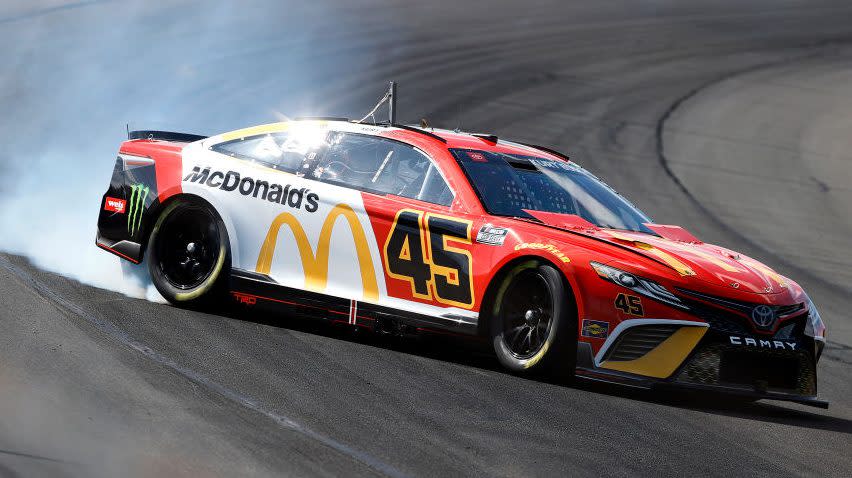
INDIANAPOLIS — Kevin Harvick questions how much NASCAR is prioritizing safety in light of driver complaints about feeling harder impacts this year and Kurt Busch missing his second consecutive race due to concussion-like symptoms.
But the lead safety official for NASCAR says “we’re always looking at ways to make things better.”
Some drivers told NBC Sports last month that they felt harder impacts this year with the Next Gen car than with the previous car. More drivers spoke up about the matter Saturday at Indianapolis Motor Speedway.
“The concerns that the drivers have just haven’t seemed to resonate into a really, really quick response into trying to make that better,” Harvick said. “That’s concerning. I know that everybody will tell you that they’re working on it.
“I don’t think they understand the extent of it and actually the extent of how bad it is when you hit stuff. … I don’t think anybody really understands, except for the drivers that have crashed into something, the violence that comes in the car. It doesn’t seem to be a high enough priority to me.”
John Patalak, managing director of safety engineering for NASCAR, told NBC Sports earlier this month that crash data this year looks similar to past years. Drivers acknowledge that but say they are feeling the impacts more.
A particular concern is when a car backs into the wall. Changes to the rear have stiffened some areas compared to the previous car.
“From the get-go, everybody could see that this car was way too stiff,” Harvick said. “When I crashed it (at Auto Club Speedway in practice), I thought the car was destroyed and it barely backed the bumper off. It just felt like somebody hit you with a hammer.”
Christopher Bell said he had a headache after he backed into the wall in the All-Star Race at Texas Motor Speedway in May. Busch also backed into the wall at Pocono before his car snapped and made a second impact on the right side.
“The car is not off-limits,” Patalak told NBC Sports about possible safety improvements. “We are actively looking at ways, we’re always looking at ways to make things better. We just shared with the drivers some simulation work we’ve done for rear impacts, looking at car structure. … We’re always investigating (the car), looking at how it performs on the racetrack and see what we can do better.”
Drivers became more vocal this weekend about safety after Busch’s accident at Pocono. There is a belief in the garage that a series of impacts this year for Busch contributed to his injury. Denny Hamlin, co-owner of Busch’s car, said that Busch “has taken a lot of hits over 25 Gs. The body can only take so much.”
“Just unfortunate for Kurt,” 23XI Racing teammate Bubba Wallace said. “You never know which hit can trigger it, right? That happened to be the one. I look back at my hit at Atlanta, and numbers-wise that was the hardest hit of my career and I was ready to climb back the next day. Crazy how it works out.”
Daniel Suarez remains confident that NASCAR will find solutions for the drivers.
“It is a bit concerning that the impact that our friend Kurt Busch had in Pocono had this kind of results,” Suarez said. “The impact didn’t look that hard, but NASCAR has a very big group of smart people working on that, and I’m sure they’re going to find answers to the questions we have.”
Corey LaJoie is on the Drivers Advisory Council that is led by NBC Sports analyst Jeff Burton. LaJoie and Joey Logano, a fellow board member of the council, are spearheading the council’s safety efforts.
LaJoie told NBC Sports that among additional areas that are being examined are the SAFER barrier, helmets and mouthguard accelerometers.
LaJoie said NASCAR may remove some pieces of foam behind the SAFER barrier at some tracks to allow the barrier to give more and potentially absorb more of an impact. NASCAR also is looking at some different padding in helmets, similar to some changes made to football helmets. LaJoie was among four drivers who raced last week with a mouthguard accelerometer, which is used to gather data on how a crash impacts a driver.
“It’s easy to point at the car, the car, the car, but the car is built for the outlier crashes, the T-bone wreck where it’s considerably safer,” LaJoie told NBC Sports. “In pretty much every area it is safer.
“But the problem is when you back one like Kurt did at Pocono, the rear, the transaxle, the way it is, and the reinforced fuel cell the way it is now in this car and how the rear clip is constructed, the previous car you back into the fence and whole rear clip would buckle underneath the rear end housing. … You had a foot and a half of crush, and now you get eight inches of crush and that’s a big difference on dispersing the energy.”
Read more about NASCAR
Ryan Blaney, Martin Truex Jr. racing for playoff spots NASCAR Xfinity Series results: AJ Allmendinger wins at Indianapolis AJ Allmendinger wins Xfinity Series race at Indianapolis Motor Speedway
Drivers raise safety concerns after Kurt Busch accident originally appeared on NBCSports.com
